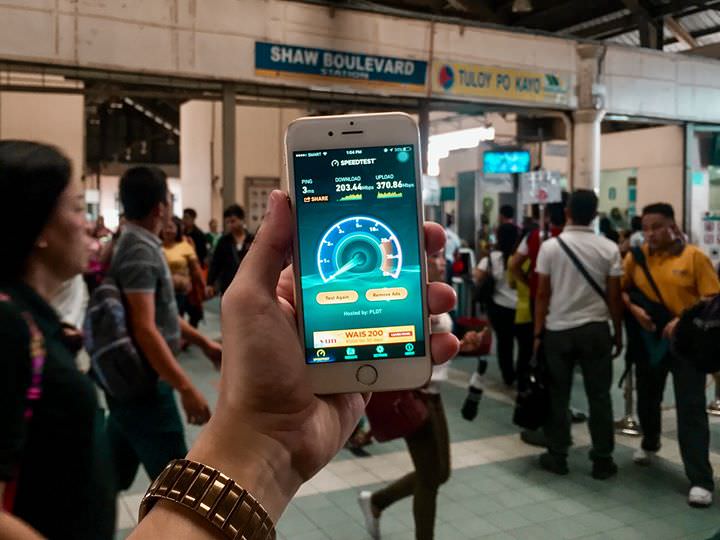Customers of PLDT wireless subsidiary Smart Communications (Smart) can look forward to improved mobile data services in Metro Manila as network upgrades continue in the country’s primary urban center.
Internal tests conducted recently show that the average download speed on Smart’s LTE service is 21.5 Mbps in North NCR areas covering Quezon City, Caloocan, Valenzuela, Novaliches, Malabon, Mandaluyong, San Juan, Pasig, Manila, Makati, Pasay, and Marikina. An average of 14.4 Mbps was reached in South NCR areas Muntinlupa, Las Piñas, Taguig and Parañaque.
These figures were bolstered by results of the latest J.P.Morgan Asia Network Quality study, which found that LTE availability in Metro Manila has increased from 49 percent at the start of the year to 63 percent in the latest study.
The study, which covered the months of April to June and cited crowd-sourced data gathered by wireless coverage research firm OpenSignal, also found that Smart has a “significant lead in LTE speeds” across all areas.
Nationwide, it maintained its lead in LTE download speeds at 11 Mbps, while it also led across areas: In Metro Manila (12.9 Mbps average download speed vs competition’s 7.6 Mbps), in South Luzon (9.5 Mbps vs 6.2 Mbps), and in the Visayas (8.3 Mbps vs 6.3 Mbps).
Improved network for the Filipino digital lifestyle
“As the Filipino lifestyle becomes more digital, we are continuously improving our network to be there for our customers like never before,” said Mario G. Tamayo, PLDT and Smart Senior Vice President for Network Planning and Engineering. “We are halfway through in North NCR, while we are close to completion in South NCR,” he added.
“With these upgrades and our growing array of digital services and content offers, we look forward to serving our customers better with a truly superior experience where they can access relevant content using our robust network anytime, anywhere, using a combination of LTE-ready devices, Smart LTE SIMs and Smart’s newest and fastest network,” Tamayo said. “The time to shift to LTE is now.”
In addition to re-equipping its cell sites to improve both indoor coverage and capacity, Smart has also been working to improve LTE coverage for thousands of Metro Manila commuters on EDSA, and improving mobile data experience in Smart Wifi-powered entertainment and lifestyle hubs called Smart Spots.
Also part of Smart’s network expansion program is the rollout of carrier-grade Smart Wifi in strategic areas such as airports and transport hubs, universities, hospitals, government offices, and the MRT and LRT. With a backhaul capacity of up to one gigabit per second, Smart Wifi can support up to 3,000 connected users with robust Wifi connectivity.
Network advisories
In the midst of these network improvement efforts, Smart customers have also reported receiving text messages advising them of the schedule of these upgrades and warning them of possible intermittent signal while these are ongoing.
“We are asking for people’s patience and understanding as we are upgrading our network facilities. We assure you that we are taking steps to minimize the impact of these activities on our subscribers. In the end, our commitment to all our subscribers is that they will enjoy progressively better mobile data services in the next few months, particularly for those using LTE devices,” said Tamayo.
To support the rise of bandwidth-heavy activities like video streaming and online gaming, Smart has committed to make LTE progressively available to 95 percent of cities and municipalities across the country by end-2018.
LTE, an all-IP network, delivers superior experience for users, particularly for data. It can also be quickly upgraded to LTE-A, which can provide even faster speeds and greater capacity to subscribers who are using LTE SIMs on LTE-capable handsets.
Subscribers who wish to upgrade their SIMs to LTE can go to the nearest Smart Store to have their SIMs replaced free of charge. Postpaid users need to also bring a valid ID for verification.
Comprehensive network modernization
Smart is currently re-equipping its cell sites to use low-frequency bands such as 700 MHz and 850 MHz to provide better indoor coverage. It is also deploying high-frequency bands like 1800 MHz and 2100 MHz to increase the cell sites’ capacity to handle more calls, texts, and ever-increasing mobile data traffic.
This comprehensive network modernization and expansion program is at the core of the PLDT group’s digital pivot. Smart’s network rollout took a big bulk of PLDT’s ramped-up capital expenditure program of P42.8 billion for 2016, which included the utilization of the new frequencies freed up with the acquisition of San Miguel Corporation’s telco assets.
Liked this post? Follow SwirlingOverCoffee on Facebook, YouTube, and Instagram.


